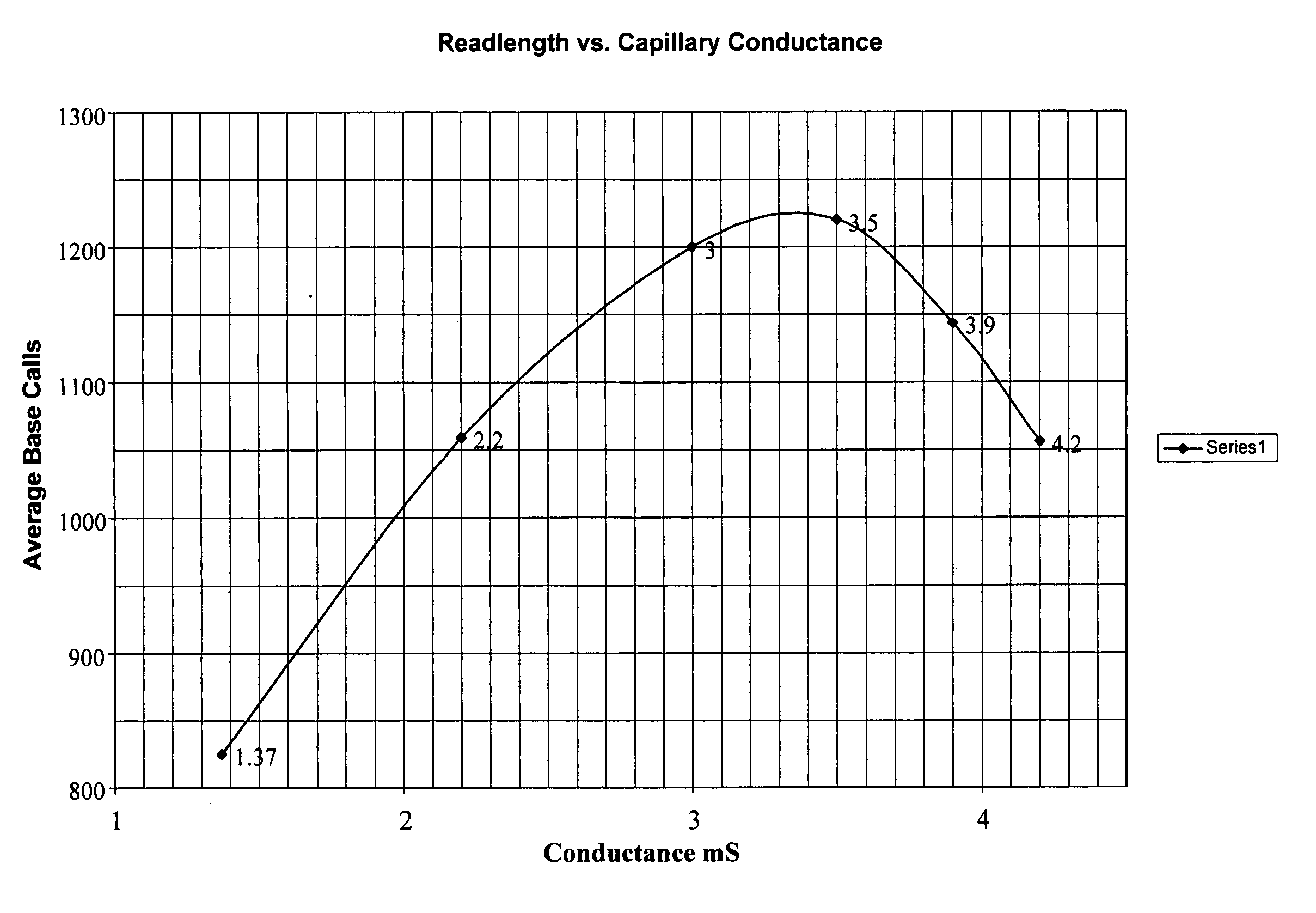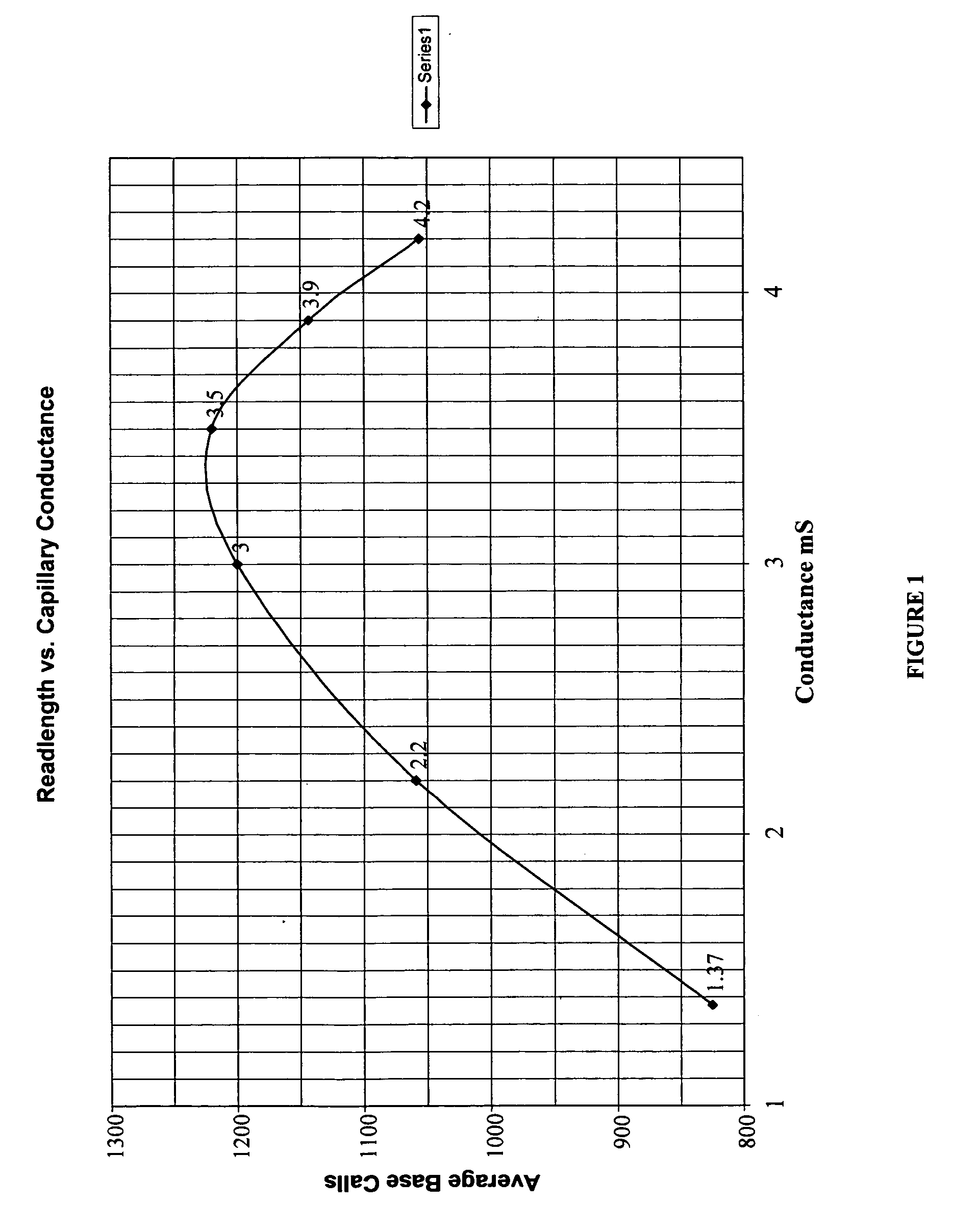High conductivity sieving matrices for high resolution biomolecule separations
a high-conductivity, sieving matrix technology, applied in the direction of fluid pressure measurement, liquid/fluent solid measurement, peptide measurement, etc., can solve the problem of deficient process resolution of large pieces or fragments of biomolecules, and achieve high conductivity, increase the total conductivity of the sieving matrix, and high conductivity
Inactive Publication Date: 2006-05-25
VOLF JANA
View PDF0 Cites 15 Cited by
- Summary
- Abstract
- Description
- Claims
- Application Information
AI Technical Summary
Benefits of technology
[0007] It is an object of this invention to provide separation media with improved separation capabilities at temperatures over 25° C. It is also an object of the present invention to provide a method of increasing the resolution of a capillary electrophoretic separation of biomolecules using a sieving medium by increasing the separation selectivity [separation between peaks or bands] by reducing aligned bias reptation.
[0008] It is another object of the invention to increase the signal to noise ratio by more effective stacking of the injected sample, while not increasing the interaction of the analyte with its surrounding environment during the separation process.
[0009] It is another object of the invention to improve the efficiency [narrower peak width] of the separation in a sieving medium by reducing a biomolecules interaction with itself or its surrounding environment.
[0010] These and other objects of the invention are achieved by creating an ionic cloud around the charged biomolecule, which is undergoing the electrophoresis process in a sieving matrix solution. The cloud should have a thickness and ionic concentration to reduce aligned biased reptation to as low a level as possible while at the same time producing an acceptable separation time. As part of this invention, higher ionic concentrations [conductivity] than have previously been used in capillary electrophoresis have been found to produce much higher resolution for larger fragments and has increased signal to noise ratio for all fragment sizes. As an unexpected benefit, higher conductivity also produces a faster sample running time and therefore, has the benefit of higher throughput and reduced expense.
[0012] Higher signal size is approximately proportional to sieving matrix's total conductivity. By increasing sieving matrix's total conductivity, more analyte can be loaded without widening the injection plug. In addition, the higher conductivity matrix allows higher concentrations of analyte to exist in the band without diffusing. The injection time and voltage can be adjusted to give an optimum plug size and signal for the buffer conductivity and analyte concentration being used.
[0013] In a preferred embodiment, a combination of urea with high conductivity buffer with a total conductivity of between 3-4 mS used during a separation process by capillary electrophoresis running at a temperature of 44° C. resulted in improved readlength and speed of separation.
Problems solved by technology
However, the procedure is still deficient in the resolution of large pieces or fragments of biomolecules.
Method used
the structure of the environmentally friendly knitted fabric provided by the present invention; figure 2 Flow chart of the yarn wrapping machine for environmentally friendly knitted fabrics and storage devices; image 3 Is the parameter map of the yarn covering machine
View moreImage
Smart Image Click on the blue labels to locate them in the text.
Smart ImageViewing Examples
Examples
Experimental program
Comparison scheme
Effect test
example 2
[0096] The same as Example 1 but with the following change: the temperature surrounding the capillary should be 60° C.
example 3
[0097] The same as Example 1 but with the following changes: the buffer solution is Tris=300 mM, TAPS=225 mM, EDTA=1 mM. The polymer solution is not heated for 80 minutes at 60° C.
example 4
[0098] The same as Example 1 but with the following changes: the buffer solution was Tris=80 mM TAPS=240 mM.
the structure of the environmentally friendly knitted fabric provided by the present invention; figure 2 Flow chart of the yarn wrapping machine for environmentally friendly knitted fabrics and storage devices; image 3 Is the parameter map of the yarn covering machine
Login to View More PUM
| Property | Measurement | Unit |
|---|---|---|
| temperature | aaaaa | aaaaa |
| temperature | aaaaa | aaaaa |
| pore size | aaaaa | aaaaa |
Login to View More
Abstract
This invention relates to methods and compositions for the separation of biomolecules using capillary electrophoresis with high conductivity sieving matrices. These methods and compositions are particularly useful to increase readlength and migrational speed.
Description
RELATED APPLICATION [0001] This application claims the benefit of Provisional Application U.S. Application No. 60 / 629,778, filed Nov. 19, 2004, the entire teachings of which are incorporated herein by reference.FIELD OF THE INVENTION [0002] This invention relates generally to capillary electrophoresis of biomolecules such as DNA, RNA and proteins, and more particularly, to an improved method of separation of fragments in a sieving medium by improved stacking and reducing the effects of aligned bias reptation and the interaction of biomolecules with their surroundings. BACKGROUND OF THE INVENTION [0003] Electrophoresis is a technique used for the separation and analysis of charged molecules or fragments of such molecules. Most frequently, electrophoretic methods are used to analyze the units comprising the building blocks of biopolymers (or biomolecules) of DNA (double or single-stranded), RNA, and amino acid polymers such as proteins or polypeptides. [0004] To apply this technique, ...
Claims
the structure of the environmentally friendly knitted fabric provided by the present invention; figure 2 Flow chart of the yarn wrapping machine for environmentally friendly knitted fabrics and storage devices; image 3 Is the parameter map of the yarn covering machine
Login to View More Application Information
Patent Timeline
 Login to View More
Login to View More Patent Type & Authority Applications(United States)
IPC IPC(8): B01D57/02G01N27/447
CPCG01N27/44747
Inventor CARSON, STEPHEN
Owner VOLF JANA
Features
- R&D
- Intellectual Property
- Life Sciences
- Materials
- Tech Scout
Why Patsnap Eureka
- Unparalleled Data Quality
- Higher Quality Content
- 60% Fewer Hallucinations
Social media
Patsnap Eureka Blog
Learn More Browse by: Latest US Patents, China's latest patents, Technical Efficacy Thesaurus, Application Domain, Technology Topic, Popular Technical Reports.
© 2025 PatSnap. All rights reserved.Legal|Privacy policy|Modern Slavery Act Transparency Statement|Sitemap|About US| Contact US: help@patsnap.com



